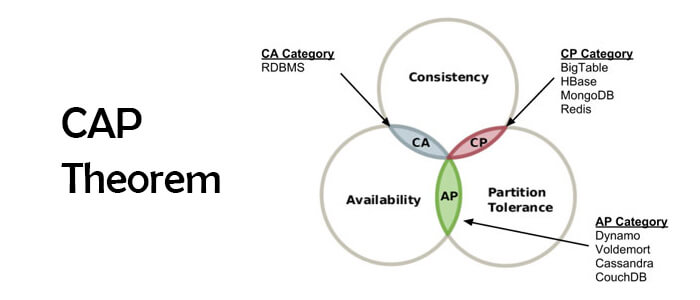The CAP theorem, a fundamental concept in distributed systems, posits that it’s impossible to simultaneously achieve Consistency (C), Availability (A), and Partition Tolerance (P) in a distributed database system. This principle plays a crucial role in guiding developers and architects in selecting the most appropriate database for their specific needs.
Understanding the CAP Theorem
The CAP theorem, introduced by computer scientist Eric Brewer, states that a distributed database system can only guarantee two out of three properties at any given time:
- Consistency (C): All nodes in the system see the same data simultaneously, ensuring data accuracy.
- Availability (A): The system remains operational and responsive, even if some nodes fail.
- Partition Tolerance (P): The system continues to function despite network partitions or communication breakdowns between nodes.
Database Categories Based on CAP Theorem
CP (Consistency and Partition Tolerance) Databases
CP systems prioritize data consistency and can handle network partitions, potentially sacrificing availability during partitions. Examples include:
MongoDB (with strong consistency settings):
- Type: NoSQL (Document-based)
- CAP Preference: CP
- Rationale: When configured for strong consistency, MongoDB may reject reads or writes during partitions to maintain data consistency.
HBase:
- Type: NoSQL (Column-family based)
- CAP Preference: CP
- Rationale: HBase employs a master-slave architecture that favors consistency, even if it means rejecting some requests during partitions.
CockroachDB:
- Type: NewSQL (Relational)
- CAP Preference: CP
- Rationale: Designed to provide SQL consistency in a distributed environment, CockroachDB may sacrifice availability during partitions to maintain consistency.
CP systems are ideal for applications that demand data accuracy at all times, such as financial services, banking, or e-commerce order processing.
CA (Consistency and Availability) Databases
CA systems maintain consistency and availability but struggle with partition tolerance. These databases are suitable for environments where partitions are rare or non-existent. Examples include:
MySQL (single-node setup):
- Type: Relational (SQL)
- CAP Preference: CA
- Rationale: In single-node configurations, MySQL maintains strong consistency and availability but doesn’t handle partitions due to its non-distributed nature.
PostgreSQL (single-node configuration):
- Type: Relational (SQL)
- CAP Preference: CA
- Rationale: Similar to MySQL, PostgreSQL ensures consistency and availability in single-node setups but lacks partition tolerance.
CA systems are well-suited for mission-critical applications like financial systems or enterprise environments where network reliability can be assumed.
AP (Availability and Partition Tolerance) Databases
AP systems prioritize availability and partition tolerance, potentially sacrificing consistency by returning stale or conflicting data. Examples include:
Cassandra:
- Type: NoSQL (Column-family based)
- CAP Preference: AP
- Rationale: Cassandra prioritizes high availability and resilience to network issues, allowing for eventual consistency.
Amazon DynamoDB:
- Type: NoSQL (Key-value)
- CAP Preference: AP
- Rationale: DynamoDB favors availability and partition tolerance, offering eventual consistency by default with options for strongly consistent reads.
Riak:
- Type: NoSQL (Key-value)
- CAP Preference: AP
- Rationale: Riak focuses on maintaining system availability during partitions, allowing temporary data conflicts.
AP systems are ideal for applications that require high availability and can tolerate eventual consistency, such as social media platforms, real-time messaging systems, and logging services.
Choosing the Right Database
Selecting the appropriate database involves careful consideration of your application’s specific requirements:
- CP systems: Choose when data consistency is paramount, as in financial services or critical transaction processing.
- CA systems: Opt for these when partitions are rare, and both consistency and availability are crucial, such as in small-scale web applications.
- AP systems: Select when high availability is essential, and eventual consistency is acceptable, like in social media platforms or logging systems.
Conclusion
The CAP theorem presents a fundamental challenge in distributed systems, forcing developers to make critical decisions about their database architecture. By understanding the trade-offs between consistency, availability, and partition tolerance, architects can make informed choices that align with their application’s unique requirements.
As the field of distributed systems continues to evolve, new database solutions may emerge that offer innovative approaches to balancing these properties. However, the core principles of the CAP theorem remain a valuable guide for navigating the complex landscape of distributed database systems.
Read more about the topic here.
Read more such articles from our newsletter here.






Add comment